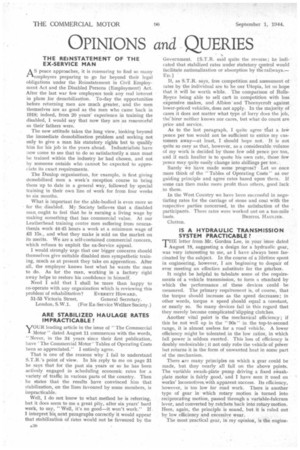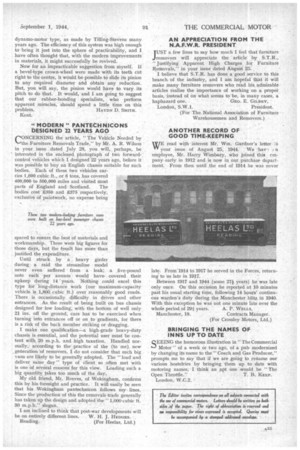OPINIONS and O UER1ES
Page 32

Page 35

If you've noticed an error in this article please click here to report it so we can fix it.
THE REINSTATEMENT OF THE EX-SERVICE MAN
As peace approaches, it is reassuring to find so many
employers preparing to go far beyond their legal obligations under the Reinstatement in Civil Employment Act and the Disabled Persons (Employment) Act. After the last war few employers took any real interest in plans for demobilization. To-day the opportunities before returning men are much greater, and the men themselves are as good as the men who came back in 1918; indeed, from 20 years' experience in training the disabled, I would say that now they are as resourceful as their fathers were.
The new attitude takes the long view, looking beyond the immediate demobilization problem and seeking not only to give a man his statutory rights but to qualify him for his job in the years ahead. Industrialists have now come to see that to do so satisfactorily a man must be trained within the industry he' had chosen, and not by someone outside whb cannot be expected to appreciate its exact requirements.
The Dunlop organization, for example, is first giving demobilized men a week's reception course to bring them up to date in a general way, followed by special training in their own line of work for from four weeks to six months.
What is important for the able-bodied is even more so for the disabled. My Society believes that a disabled man, ought to feel that he is earning a living wage by making something that has commercial value. At our Leatherhead training centre men suffering from neurasthenia work 44-45 hours a week at a minimum wage of a 15s., and what they make is sold on the market on its merits. We are a self-contained commercial concern, which refuses to exploit the ex-Service appeal.
I would strongly urge that our bigger concerns should themselves give suitable disabled men sympathetic training, much as at present they take on apprentices. After an, the employer knows best what he wants the man to do. As for the man, working in a factory right away helps to restore his confidence in himself.
Need I add that 1 shall be more than happy to co-operate with any organization which is reviewing this
problem' of rehabilitation? EVERETT HOWARD,
51-53 Victoria Street, General Secretary. London, S.W.1. (For Ex-Service Welfare Society.) ARE STABILIZED HAULAGE RATES IMPRACTICABLE?
YOUR leading article in the issue of "The Commercial Motor" dated August 11 commences with the words, " Never, in the 34 years since their first publication, have The Commercial Motor' Tables of Operating Costs been so appreciated." I entirely agree.
That is one of the reasons why I fail to understand S.T.R. 's point of view. In his reply to me on page 31 he says that for the past six years or so he has been actively engaged in scheduling economic rates for a variety of traffic in various parts of the country. Then he states that the results have convinced him that stabilization, on the lines favoured by some members, is impracticable.
Well, I do not know to what method he is referring, but it does seem to me a great pity, after six years' hard work, to say, "Well, it's no good—it won't work." If. I interpret hi; next paragraphs correctly it would appear that stabilization of rates would not be favoured by the A30 Government. [S.T.R. said quite the reverse ; he indicated that stabilized rates under statutory control would facilitate nationalization or absorption by the railways.— ED.] If, as S.T.R. says, free competition and assessment of rates by the individual are to be our Utopia, let us hope that it will be worth while. The comparison of RollsRoyce being able to sell cars in competition with less expensive makes, and Albion • and Thornycroft against lower-priced vehicles, does not apply. In the majority of cases it does not matter what type of lorry does the job, the' hirer neither knows nor cares, but what do count are price and service.
As to the last paragraph, I quite agree that a few pence per ton would not be sufficient to entice my customers away—at least, I should hope not. It is not quite so easy as that, however, as a considerable volume of my work is decided by those few odd pence per ton, and if each haulier is to quote his own rate, those few pence may quite easily change into shillings per ton.
Surely we have made some progress? Let us once more think of the "Tables of Operating Costs" as our guiding principle and agree rates based upon them. If some can then make more profit than others, good luck to them.
In the West Country we have been successful in negotiating rates for the carriage of stone and coal with the respective parties concerned, to the satisfaction of the participants. These rates were worked out on a ton-mile
basis. BRISTOL HAULIER. Clutton.
IS A HYDRAULIC TRANSMISSION SYSTEM PRACTICABLE?
THE letter from Mr. Gordon Lee, in your issue dated
August 18, suggesting a design for a hydraulic gear, was very interesting to me, as I have always been fascinated by the subject. In the course of a lifetime spent in engineering, however, I am beginning to despair of ever meeting an effective substitute for the gearbox.
It might be helpful to tabulate some of the requirements of a vehicle transmission, to form a st'andard by which the performance . of these devices could be measured. The primary requirement is, of course, that the torque should increase as the speed decreases ; in other words, torque x speed should equal a constant, or nearly so. So many devices fail in this regard that they merely become complicated slippingclutches.
Another vital point is the mechanical efficiency; if this be not well up in the " 90s " in the top-to-second range, it is almost useless for a road vehicle. A lower efficiency might be tolerated in the low ratios, in which full power is seldom exerted. This loss of efficiency is doubly undesirable; it not only robs the vehicle of pdwer but returns it in the form of unwanted heat in some part of the mechanism.
There are many principles on which a gear could be made, but they nearly all fail on the above points. The variable swash-plate pump driving a fixed sashplate motor is fairly good, and I have seen it used on works' locomotives. with apparent success. Its efficiency, however, is too low for road work. There is another type of gear in which rotary motion is turned into reciprocating motion., passed through a variable-fulcrum lever, and converted by ratchets back into rotary motion. Here, again, the principle is sound, but it is ruled out by low efficiency and excessive wear.
The most practical gear, in my opinion, is the engine dynamo-motor type, as made by Tilling-Stevens many years ago. The efficiency of this system was high enough to bring it just into the sphere of practicability, and I have often thought that, with the modern improvements in materials, it might successfully be revived.
Now for an impracticable suggestion from myself. If a bevel-type crown-wheel were made with its teeth cut right to the centre, it wOuld be possible to slide its pinion to any required diameter and obtain any reduction. But, you will say, the pinion Would have to vary its pitch to do that. It would, and I am going to suggest that our rubber-bonding specialists, who perform apparent miracles, should spend a little time on this problem. HAYDN D. SMITH. Kent.
" MODERN " PANTECHNICONS DESIGNED 22 YEARS AGO CONCERNING the article, "The Vehicle Needed by the Furniture Removals Trade," by Mr. A. R. Wilson in your issue dated July 28, you will, perhaps, be interested in the enclosed photograph of two forwardcontrol vehicles which I designed 22 years ago, before it was possible to buy an English chassis suitable for such bodies. Each of these two vehicles carries 1,600 cubic ft., or 6 tons, has covered 400,000 to 500,000 miles and visited most parts of England and Scotland. The bodies cost -£350 and £375 respectively, exclusive of paintwork, no expense being
spared to ensure the best of materials and workmanship. These were big figures for those days, but the result has more than justified the expenditure.
Until struck by a heavy girder during, a raid the streamline model never even suffered from a leak; a five-pound note each per annum would havecovered their upkeep during 14 years. Nothing could excel this type for long-distance work (our maximum-capacity vehicle is 1,800. cubic ft.) over reasonably good roads. There is occasionally difficulty in drives and other entrances. As the result of being built on bus chassis designed for low loading, with the bottom of well only 21 ins, off the ground, care has to be exercised when turning into entrances off or on to gradients, for there is a risk of the back member striking or dragging.
I make one qualification—a high-grade heavy-duty chassis is essential, and the potential user must be content with 20 m.p.h. and high taxation. Handled normally,. according to the practice of the (to me) new generation of removers, I do not consider that such big vans are likely to he generally adopted. The "load and deliver sime. day" type of client so often met with is one of several reasons for this view. Loading such a big quantity takes too much of the day.
My old friend, Mr. Reeves, of Wokingham, confirms this by his foresight and practice. It will easily be seen that his Wokingham pantechnicon follows my lines. Since the production of this the removals trade generally has taken up the design and adopted the-" 1,000 cubic ft_ 30 m.p.h." slogan.
I am inclined to think that post-war developments will be on entirely different lines. W. H. J. HEDGES.
Reading. (For Heelas, Ltd.) AN APPRECIATION FROM THE • N.A.F.W.R. PRESIDENT JUST a few lines to say how much I feel that furniture removers will appreciate the article by S.T.R.. "Justifying Apparent High Charges for Furniture Removals," in your issue dated August 25.
I believe that S.T.R. has done a good service to this branch of the industry, and I am hopeful that it will make many furniture removers who read his admirable articles realize the importance of working on a proper basis, instead of on what seems to be, in many cases, a President.
(For The National Association of Furniture Warehousemen and Removers.) ANOTHER RECORD OF GOOD TIME-KEEPING WE read with interest Mr. Wm. Gardner's letter " your issue of August 25, 1944. We 'hay' n employee, Mr. Harry Wimbury, who joined this empany early in 1912 and is now in our purchase department. From then until the end of 1914 he was never late. From1914 to 1917 he served in the Forces, returning to us late in 1917.
Between 1917 and 1944 (some 27i years) he was late only once. On this occasion he reported at 10 minutes past his usual starting time, following 14 hours' continuous warden's duty during the Manchester blitz in 1940. With this exception he was not one minute late over the whole period of 291 years. A. P. WELLS, Manchester, 18. Contracts Manager.
(For Crossley Motors, Ltd.) BRINGING THE NAMES OF INNS UP TO DATE QEEING the humorous illustration in "The Commercial 1--/
Motor" of a week or two ago, of a pub modernized by changing its name to the "Coach and Gas Producer," prompts me to say that if we are going to rename our various hostelries by bringing them up to date with motoring names, I think an Apt one would be "The Open Throttle." T. B. KEEP. London, W.C.2.




















































